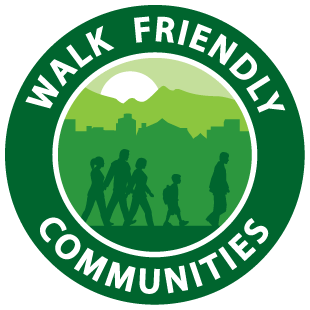Community Highlights
Atlanta is designated as a Bronze-level community due to its impressive urban trail system, wonderful Open Streets event, high-quality infill development, and high transit mode share. The city has also recently completed impressive road diets on several of its major roadways. Highlights of Atlanta’s application include:
- Atlanta Streets Alive closes a street segment to motorized traffic and opens it up for people to play, walk, and bike. At least two miles of street are closed for four hours and the route rarely stays the same. The event is organized by the Atlanta Bicycle Coalition and it is held multiple times a year. More than 100,000 attendees enjoyed three miles of open streets at their 2018 event.
- Atlanta is expanding its efforts to count pedestrians and bicyclist along key corridors and trails throughout the City.
- The Atlanta City Studio, a pop-up urban design group within the City’s planning department, promotes collaboration and innovative design across multiple agencies and departments.
- The Atlanta BeltLine project is designed to promote connectivity and transit alternatives by converting the 22 mile historic rail corridor currently surrounding the urban center to include 33 miles of multi-use trails, a pedestrian friendly rail system, and over 1,000 acres of greenspace. Eleven miles of new trails have already opened as part of the Beltline project, adding to the more than 100 miles of existing trails in Atlanta. The city also has a zoning overlay district designed to support transit-oriented, walkable development around the BeltLine.
- Art on the Atlanta BeltLine brings temporary public art exhibitions to BeltLine trail users. The program combines walking and art with the annual Lantern Parade, which attracted over 10,000 participants and spectators at the 2013 event.
- Improving pedestrian safety continues to be a major focus in the City’s transportation planning efforts. In the past two years, the City has installed no fewer than 16 Pedestrian Hybrid Beacons and rectangular rapid flashing beacons (RRFBs) at strategic locations. The City’s Midtown community improvement district has optimized approximately 30 traffic signals to reduce pedestrian wait times and provide safer crossing by implementing leading pedestrian intervals, in addition to timing traffic signals to reduce vehicle speeds to 25mph during off-peak times.
- Using road diets, Atlanta has improved safety and comfort for pedestrians on some of the city’s biggest streets. For example, a major arterial was converted from six lanes of traffic traveling in one direction to a four-lane roadway with six to eight feet of widened sidewalk and four foot wide bicycle facilities. The City of Atlanta routinely installs curb extensions on all streets that require on-street parking. In the past three years, the city has made significant progress with these installations, particularly in high pedestrian areas.
- The comprehensive Wayfinding Signage Program for Downtown and Midtown Atlanta includes visually appealing, pedestrian-scale signs and maps. The initiative was the result of collaboration between the City of Atlanta and community development organizations.

